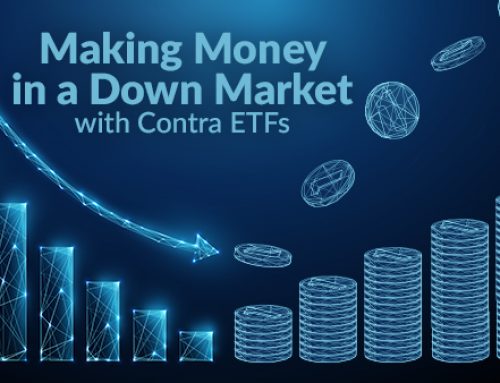ETFs and shorting–maybe you know about each of these financial terms separately, but didn’t know they could be utilized together. Rather than with ordinary or “long” investing, shorting an ETF allows you to profit off of its decline in value.
And when it comes to ETFs, shorting is actually easier than you may have realized – thanks to inverse ETFs. You can purchase these, which are sometimes called contra ETFs, and will inherently be “shorting” the ETF in question as the inverse ETF performs, well, inverse to the actual index.
So, if you want to learn more about how to short sell an ETFs, continue reading as we discuss when you should consider doing so, and how you can be successful with this strategy. We’ll start by introducing you to ETFs if you’re new to this asset class.
What Is An ETF?
First, let’s cover what an ETF is. ETF stands for Exchange Traded Fund. This is an investment product that is a blend of mutual funds and individual stocks. This means that ETFs enjoy similar diversification benefits as a mutual fund does while being as simple to trade as an individual stock. You get the best of both worlds with ETFs!
Essentially, an ETF is a bundle of various investments, like stocks, which allows you to invest in a number of shares from different companies at the same time. Technically, the fund provider is the entity that actually owns each of the stocks in the ETF outright. They then create a fund to mimic the performance of those stocks, which are then broken up and sold in portions to investors.
So, owning an ETF does not mean you own each of the underlying assets, but you experience much of the same price swings and market movements as if you actually did. Typically, ETFs are built to track the various indices, commodities, or sectors of the stock market, giving investors exposure to a number of different companies and assets through one investment vehicle. Plus, the fees to buy an ETF are much lower than for traditional funds.
What Is An Inverse ETF (Contra ETF)?
Before we get into how to short an ETF, we will discuss a variation of the ETF as we described above, which is the inverse ETF. These are also referred to as a “short ETF” or “bear ETF”. You’ll even see these referred to as a contra ETF – especially in the VectorVest platform. This investment product is an ETF that is made up of derivatives that will allow holders to gain from the decline of an underlying benchmark, either on a one-to-one basis or on an exaggerated basis if the inverse ETF is leveraged.
For example, say you are invested in a contra ETF that tracks the daily value of the S&P 500 one-to-one and the index declines 2% that day. The change in the value of the inverse ETF should be a 2% gain. Or, if the contra ETF is leveraged in the same example, you could expect something like a 5% gain. Though it is often compared to shorting stocks on sentiment, the technical aspects of these two strategies differ from one another. But, unlike shorting stocks, this strategy can be incredibly straightforward. You simply purchase a contra ETF and it works inverse to the market. These investments are typically utilized on a short-term basis and for hedging strategies as opposed to over the long term. We’ll talk more about the beauty of purchasing inverse ETFs later on – as they greatly simplify the idea of “shorting an ETF”. First, let’s explain the basic principles of how to short an ETF.
Can You Short Sell An ETF?
So, can you short sell an ETF like you could with any ordinary stock? The answer is yes! Just as when short selling stocks, you can short an ETF when you expect its value to go down in the coming period. This allows you to benefit from its decline as opposed to seeing your portfolio performance suffer from it if you owned it outright.
When considering how to short an ETF, you take exactly the same steps as you would with any other stock. In simple terms, this requires you to borrow shares of the ETF from your broker and sell them to a willing buyer, hoping that its value will decline and you can then purchase the shares of the ETF at a lower price before returning them back to the broker. When done successfully, you profit from the difference between what your proceeds were from their sale and what you had to pay to purchase them later.
This is a lot of work and can get pretty complex. This deters many investors from taking the time to actually short ETFs. But these days you don’t have to jump through hoops to “fade the market” so to speak. It can be as simple as purchasing an inverse ETF – as these inherently perform opposite (inverse) to what the index in question is doing. Allow us to explain how these work and what makes them such a great tool in your investment portfolio.
How Buying Inverse ETFs (Contra ETFs) Makes Shorting ETFs So Simple
As you can see from the section above, short selling ETFs is complicated. But it doesn’t have to be this way – with inverse ETFs or contra ETFs, your purchase is a “short” in itself. All you have to do is purchase the inverse ETF of whichever fund you want to bet against. These inverse ETFs perform opposite of the index in question. While the ETF itself may be going down, your inverse ETF will be going up.
Sounds too good to be true, right? No need to worry about the actual short selling element? This is the beauty of contra ETFs. You don’t have to waste your time or energy with the actual complexity of short selling in its truest form. You simply purchase the inverse of whichever ETF or index you want to bet against and see your trade through.
When Buying Inverse ETFs May Be A Good Idea
Investors find it fitting to buy inverse ETFs when they’re hedging against risk elsewhere in their portfolios. Or, sometimes investors will use shorting ETFs as a way to take profits when they’re speculating the markets and expect a security to fall in value in the near term. Below, we discuss each of these scenarios more in-depth.
Hedging Against Risk
One instance where you may want to buy inverse ETFs is when you are looking to hedge against risk that lies elsewhere in your portfolio. In this case, the short strategy isn’t necessarily for pure profit, but you’re trying to mitigate your overall risk and offset potential losses, like when managing the risk of your stock options.
For example, say you have a “long” position of a certain ETF in your portfolio and you expect to see some price swings and fluctuations in the near term. So while you’re not necessarily bearish on the ETF in general, you could enter a short position on it to profit on its losses in the meantime without having to sell your long position.
This is also quite common for those who already have stock options on certain investments, as it can help mitigate their downside risk.
Taking Profits
Another reason you might want to buy contra ETFs is for pure profit. If you expect the value of an index, industry, or commodity to decline in value in the coming periods, shorting the ETF will allow you to profit from its decline in value.
If you complete the trade profitably, you were able to borrow shares of the ETF from your broker and sell them, pocket the proceeds, and buy the shares at a later date when the price dropped and you profited from the difference.
How To Short An ETF: Strategies For Success When Buying Contra ETFs
Taking into consideration the instances where it makes sense to buy contra ETFs, there are a few additional strategies that can help you be more successful. Plus, many of the following tips are applicable when you’re shorting stocks as well.
Do your research
Short selling is inherently risky, even more risky than when taking a long position. So, short selling should largely be done by financial professionals who know what indicators to look out for, and when it’s a good idea to short ETFs.
So, do your research on the ETF you want to short and justify your decision based on a reasonable expectation that it will decline in value over the coming period. There are a number of ways you can go about this, but it’s important that you are prepared to short an ETF and increase the likelihood that this trade is profitable.
Short struggling industries
It may be tempting to buy an inverse ETF of an industry that’s on a downward trend currently. But, try not to short industries that are generally strong and simply show reactions to short-term trends. These will likely experience a price correction sooner rather than later. Instead, focus on industries that are already struggling and conflicted. There are more downward trends working against them which will be better for your shorting strategy.
Set Yourself Up For Success While Shorting ETFs With VectorVest
Above all, using a powerful and sophisticated tool that can provide you with real-time, relevant information and indicators cannot be understated. With the right tools at your fingertips, you can have the upper-hand in the markets.
With VectorVest, you don’t have to play the guessing games of when it’s the right time to buy and when it’s the right time to sell–you will be able to access clear recommendations that can help you make more profitable trades with our stock forecasting tools. And you don’t have to take our word for it, you can try it yourself today with a free stock analysis. You’ll see for yourself how our system offers a clear buy, sell, or hold recommendation for any given stock – based on value, safety, and timing. Once you’ve experienced investing with VectorVest, you’ll never go back – it’s like investing on easy mode!
Final Thoughts On How To Short Sell An ETF (Buying Inverse ETFs)
By learning how to short an ETF, you are better equipped to speculate the markets and enjoy profit gains in your portfolio even when everyone else is scrambling to cover their losses.
And as you know now, the days of having to actually short an ETF are long gone. Now, you can simply purchase a contra ETF and allow it to do all the work for you. By making the purchase in the contra ETF, you’re investing in an asset that performs opposite to that of the index in question. It makes shorting an ETF as simple as ever. Even still, setting yourself up for success with the right tools is imperative. And that’s where VectorVest comes in.
Many investors are turning to VectorVest, a powerful tool that provides you with actionable insights that can lead to more profitable trades. If you want to make more money in the stock market and simplify the complex indicators and data that are notorious for leaving investors overwhelmed, give VectorVest a try today. You’ll never go back to looking at technical indicators the same way again!






Leave A Comment